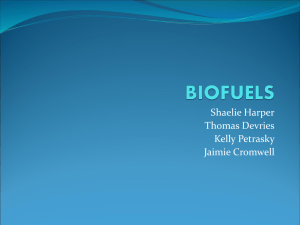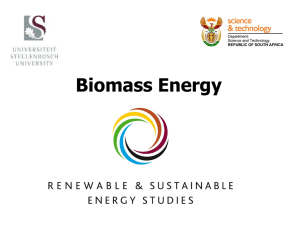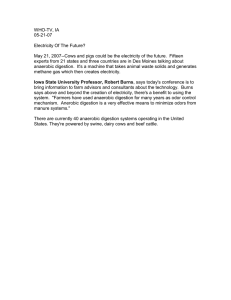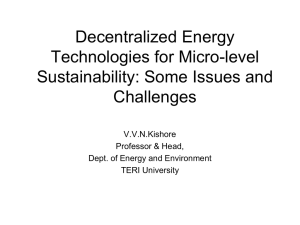Document 13359555
advertisement
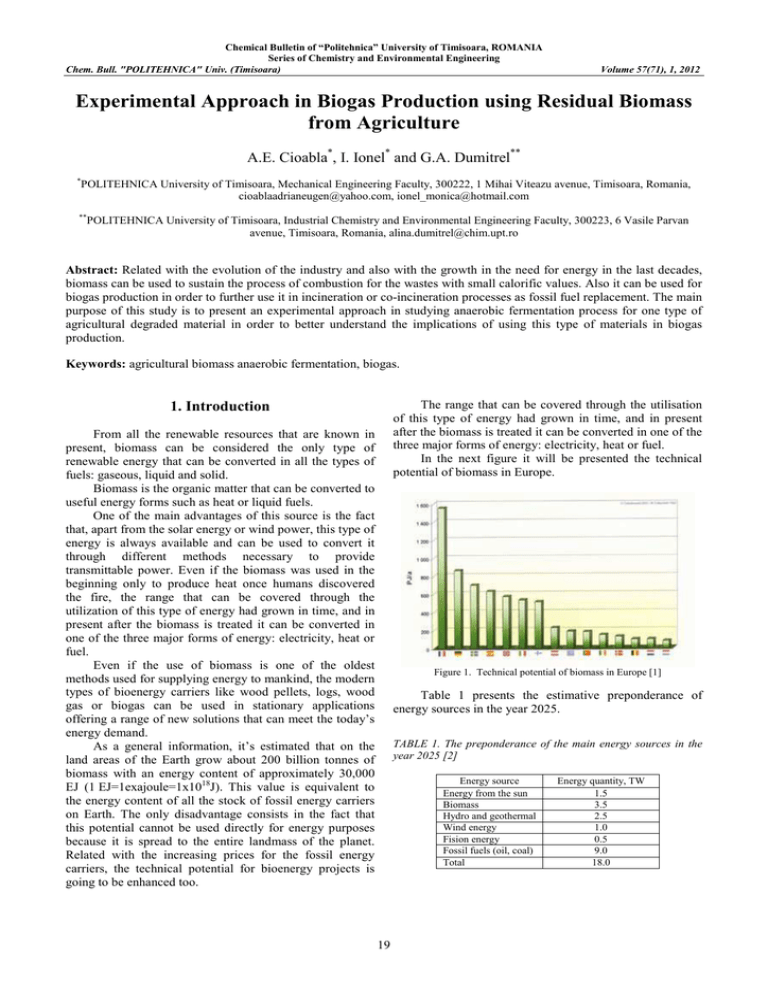
Chemical Bulletin of “Politehnica” University of Timisoara, ROMANIA Series of Chemistry and Environmental Engineering Chem. Bull. "POLITEHNICA" Univ. (Timisoara) Volume 57(71), 1, 2012 Experimental Approach in Biogas Production using Residual Biomass from Agriculture A.E. Cioabla*, I. Ionel* and G.A. Dumitrel** * POLITEHNICA University of Timisoara, Mechanical Engineering Faculty, 300222, 1 Mihai Viteazu avenue, Timisoara, Romania, cioablaadrianeugen@yahoo.com, ionel_monica@hotmail.com ** POLITEHNICA University of Timisoara, Industrial Chemistry and Environmental Engineering Faculty, 300223, 6 Vasile Parvan avenue, Timisoara, Romania, alina.dumitrel@chim.upt.ro Abstract: Related with the evolution of the industry and also with the growth in the need for energy in the last decades, biomass can be used to sustain the process of combustion for the wastes with small calorific values. Also it can be used for biogas production in order to further use it in incineration or co-incineration processes as fossil fuel replacement. The main purpose of this study is to present an experimental approach in studying anaerobic fermentation process for one type of agricultural degraded material in order to better understand the implications of using this type of materials in biogas production. Keywords: agricultural biomass anaerobic fermentation, biogas. The range that can be covered through the utilisation of this type of energy had grown in time, and in present after the biomass is treated it can be converted in one of the three major forms of energy: electricity, heat or fuel. In the next figure it will be presented the technical potential of biomass in Europe. 1. Introduction From all the renewable resources that are known in present, biomass can be considered the only type of renewable energy that can be converted in all the types of fuels: gaseous, liquid and solid. Biomass is the organic matter that can be converted to useful energy forms such as heat or liquid fuels. One of the main advantages of this source is the fact that, apart from the solar energy or wind power, this type of energy is always available and can be used to convert it through different methods necessary to provide transmittable power. Even if the biomass was used in the beginning only to produce heat once humans discovered the fire, the range that can be covered through the utilization of this type of energy had grown in time, and in present after the biomass is treated it can be converted in one of the three major forms of energy: electricity, heat or fuel. Even if the use of biomass is one of the oldest methods used for supplying energy to mankind, the modern types of bioenergy carriers like wood pellets, logs, wood gas or biogas can be used in stationary applications offering a range of new solutions that can meet the today’s energy demand. As a general information, it’s estimated that on the land areas of the Earth grow about 200 billion tonnes of biomass with an energy content of approximately 30,000 EJ (1 EJ=1exajoule=1x1018J). This value is equivalent to the energy content of all the stock of fossil energy carriers on Earth. The only disadvantage consists in the fact that this potential cannot be used directly for energy purposes because it is spread to the entire landmass of the planet. Related with the increasing prices for the fossil energy carriers, the technical potential for bioenergy projects is going to be enhanced too. Figure 1. Technical potential of biomass in Europe [1] Table 1 presents the estimative preponderance of energy sources in the year 2025. TABLE 1. The preponderance of the main energy sources in the year 2025 [2] Energy source Energy from the sun Biomass Hydro and geothermal Wind energy Fision energy Fossil fuels (oil, coal) Total 19 Energy quantity, TW 1.5 3.5 2.5 1.0 0.5 9.0 18.0 Chem. Bull. "POLITEHNICA" Univ. (Timisoara) Volume 57(71), 1, 2012 It is considered that biomass accounts for about 12% of the world's energy supply; the largest part of this use is in developing countries. Agricultural residues, commercial wood and logging residues, animal wastes, the organic portion of municipal solid waste, and methane gas from landfills can all be used to create energy in a process that has several advantages over fossil fuels. This is a virtually limitless option because of the diversity of sources. better understand the potential of this type of biomass for further studies at larger scale. 2. Experimental Degraded grains of two row barley were used as substrate for biogas production through anaerobic digestion process. 2.1. Description of pilot plant The pilot plant used for producing biogas from biomass through anaerobic digestion is presented in figure 4. From the biomass deposit, the used material is passed through a mill, and then it’s sent to the tank where the preparation of the suspension of biomass is made (1). The biomass suspension is transported with the help of the pump (2) and introduced into the fermentation reactors (3). The correction agent tank for the pH assures, through the control system, the conditions for the process of anaerobic fermentation. The resulted biogas is passed through a filter for retaining the H2S (5) and after that, through a system used for retaining CO2 (6), after which takes place the CO2 desorption and the compression of the CO2 in the adjacent system and the purified biogas is sent for being used (8). The used material is discharged through the means of a gravimetric system (9), and the solid material is retained for being dried using the natural drying, and after that is sent to a compost deposit for being used as a soil fertilizer. A part of the resulting liquid is neutralized when the case, in the system (10) and sent to the sewerage network, or is transported by the recirculation pump (2) from the suspension preparation tank (1). The fermentation reactors are thermostat heated with the system (11). For the homogenization of the suspension is used a bubbling system (12) made by polypropylene pipes to avoid the possible corrosion. Also, for depositing small quantities of biogas of the purpose of analyzing, the installation is equipped with a small tank (13) positioned at the top of the reservoirs. Figure 2. Projection of the energy resources until the year 2100 [3] There are several processes to transform biomass into solid, liquid, or gaseous secondary energy carriers: these include combustion, thermo – chemical transformation via carbonization, liquefaction or gasification, physico chemical transformation by compression, extraction, transesterification, and biochemical transformation by fermentation with alcohol or aerobic and anaerobic decomposition. In figure 3 are presented the technologies used for transforming the biomass into secondary energy resources. One of the processes used at the Unconventional Technologies from the Mechanical Faculty at the Politehnica University in Timisoara is regarding obtaining the biogas using the anaerobic fermentation of different types of biomass and after the analyzing the result, in finding the best recipes in order to attain the best quality of the obtained biogas. As part of the conducted research, this article will underline different process characteristics, as well of the general overview for the used material chemical properties before and after the anaerobe fermentation, together with the quality and the produced quantity of biogas in order to Figure 3. Applied technologies to transform biomass into secondary energy resources [3] 20 Chem. Bull. "POLITEHNICA" Univ. (Timisoara) Volume 57(71), 1, 2012 The reactors were feed at the beginning of the experiment with approximately 75 kg dry biomass and 2000 L water. Biogas production was measured daily, the pressure difference being dropped with the help of a semiautomated system and after wards through a gas counter. Methane (CH4) and carbon dioxide (CO2) compositions (v/v) were measured using a Delta 1600 IV gas analyzer. Temperature and pH were also continuously measured online. 40.0 0 Temperature, [ C] 35.0 30.0 25.0 20.0 15.0 10.0 5.0 0.0 0 10 20 30 40 50 60 70 Time [days] Figure 5. Temperature variation during anaerobic digestion process In addition to temperature, pH is an important process parameter for management of biogas processes. pH variation during anaerobic digestion process is presented in figure 6. From figure 5 it can be observed that, for wheat bran, the initial pH values are lower than for the mixture batch and the general tendencies are of increasing from values of 6.5 to 7 – 7.1 after 40 days. The behaviour for the mixture batch is much more linear, starting from 6 with small peaks inside the first 12 days and stabilizing near the domain of 6.8 – 7.1 for the rest of the process. This indicates a better behaviour of mix during anaerobic fermentation, much more easy to be controlled than for the first batch of material. igure 4. Schematic configuration of pilot plant used to produce biogas from biomass 2.2. Methods of analysis 9.0 The general characteristics of substrate before and after the anaerobic digestion process were determined. The measured properties and the methods used were: - determination of moisture content – oven dry method, according to Standard EN 14774 [4] ; - determination of ash content, according to Standard EN 14775 [5]; - determination of calorific value, according to Standard EN 14918 [6]; - determination of major elements, according to Standard EN 15290 [7]; - determination of minor elements, according to Standard EN 15297 [8]; - determination of total content of carbon, hydrogen and nitrogen – Instrumental methods, according to Standard EN 15104 [9]. 8.0 7.0 pH 6.0 5.0 4.0 3.0 2.0 1.0 0.0 0 10 20 30 40 50 60 70 Time [days] Figure 6. pH variation during anaerobic digestion process 0.800 3 Daily biogass production, [m] 0.900 3. Results and Discussion The variation of temperature during anaerobic digestion process of studied substrate is presented in figure 5. From figure 5, it can be observed that the temperature average value is around 29°C, which means that the process take place under a cryophilic regime. 0.700 0.600 0.500 0.400 0.300 0.200 0.100 0.000 0 10 20 30 40 50 60 70 Time [days] Figure 7. Daily biogas production during anaerobic digestion process 21 Chem. Bull. "POLITEHNICA" Univ. (Timisoara) Volume 57(71), 1, 2012 TABLE 5. Heavy metals concentration of substrate before and after anaerobic digestion CH4 and CO2 conc. [%] 80 70 60 50 40 30 20 10 0 0 10 20 30 40 50 60 70 Time [days] CH4 CO2 No. Heavy metal 1 2 3 4 5 Cr Mn Ni Cu Pb Heavy metal concentration in substrate before digestion, [ppm] <5 30 <5 <5 450 Heavy metal concentration in substrate after digestion,[ppm] 30 130 10 10 230 Figure 8. Evolution of CH4 and CO2 concentration during anaerobic digestion process 4. Conclusions The general characteristics of the substrate before and after anaerobic digestion are given in table 2 and 3. The experimental results outlined in the previous sections of this study have showed that damaged two row barley grains are very suitable substrates for anaerobic digestion. The cumulative biogas yield over 65 days of retention time period was found as 26.2 m3. The evolution of methane concentration value in the produced biogas during anaerobic digestion has been showed that the quality of biogas is better after 30 days of anaerobic digestion process. TABLE 2. Main feedstock parameters at the beginning and end of the process No. Substrates Beginning of the process 1. Two row barley End of the process 2. Two row barley Humidity [%] Ash content [%] Lower heating value [kJ/kg] Higher heating value [kJ/kg] 10.7 2.22 18354 16763 0.75 56.9 9003 8338 TABLE 3. Main feedstock parameters at the beginning and end of the process No. Substrates Carbon content [%] Beginning of the process 1. Two row barley 40.1 End of the process 2. Two row barley 27.4 Hydrogen content [%] Nitrogen content [%] Volatile matter content [%] 6.5 1.38 82.4 3.0 1.09 59.1 ACKNOWLEDGMENT This paper was supported by the project "Develop and support multidisciplinary postdoctoral programs in primordial technical areas of national strategy of the research - development - innovation" 4D-POSTDOC, contract nr. POSDRU/89/1.5/S/52603, project co-funded from European Social Fund through Sectorial Operational Program Human Resources 2007-2013. The chemical composition of the substrate before and after using in the anaerobic digestion process is presented in table 4 and 5. REFERENCES TABLE 4. Chemical composition of the substrate before and after anaerobic digestion No. Chemical compound 1 2 3 4 5 6 7 8 9 10 11 Mg Al Si P S Cl K Ca Mn Fe Zn Concentration in substrate before digestion, [mg/kg] 540 80 3790 2360 1140 970 4590 1150 20 70 30 1. Planning and Installing Bioenergy Systems – a guide for installers, architects and engineers, James and James (Science Publishers) Ltd., 2007. 2. European Commission, Biomass Conversion Technologies – Achievements and prospects for heat and power generation, European Communities, 1998. 3. D. Dublein and A. Steinhauser, Biogas from waste and renewable resources, WILEY-VCH Verlag GmbH & Co. KGaA, Weinheim, 2008. 4. EN 14774 – Solid biofuels – Determination of moisture content – Oven dry method; 5. EN 14775 - Solid biofuels - Determination of ash content; 6. EN 14918 - Solid biofuels – Determination of calorific value; 7. EN 15290 – Solid biofuels – Determination of major elements; 8. EN 15297 – Solid biofuels – Determination of minor elements; 9. EN 15104 – Solid biofuels – Determination of total content of carbon, hydrogen and nitrogen – Instrumental methods. Concentration in substrate after digestion, [mg/kg] 640 1000 4210 6980 1310 110 430 284500 70 700 70 Received: 17 April 2012 Accepted: 20 June 2012 22
